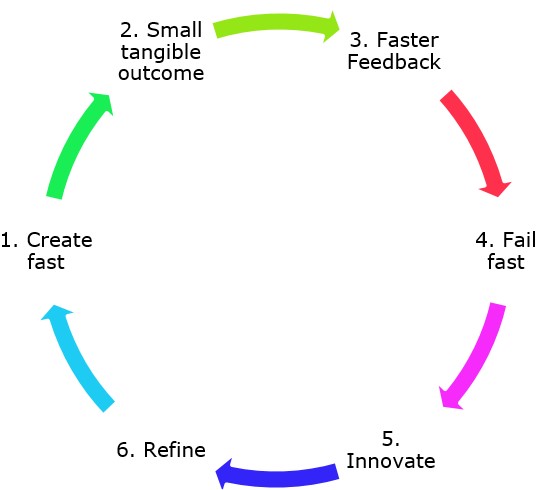AGILE SOLUTION DELIVERY – ROLE OF AGILE U0026AMP; DEVSECOPS TO SPEED UP DIGITAL TRANSFORMATIONS
June 30, 2023
Introduction
A couple of decades ago, to deposit or withdraw money from the account, we as customers used to visit a bank branch, fill up a deposit or withdrawal slip, get a metal token and wait in queue for few minutes to an hour to complete a banking transaction. A lot of effort was spent in the whole process and in big families, a roaster of who would take up the work every month!!! The teller in a bank was also overwhelmed with so much transaction volume and used to work continuously without a break. The job also demanded accuracy in recording transactions manually in ledgers.
Fast forward to 90s, we witnessed the emergence of digital and online banking. Yes, computers were used to do lot of heavy lifting. Yes, we started digital transformation few decades ago. We did online fund transfer two decades ago. ATMs were installed in various locations across the world for ease of withdrawals. Wire transfers enabled faster transfer of money across the globe, across different banks. Same is the case with respect to usage of computers and technology in other industries such as healthcare, telecom, manufacturing, public sector, education, etc.
Business case
So, the big question is, why there is so much focus on digital transformation today? What is so special and peculiar about the digital transformation that we are embarking today? Let’s dive deep into those aspects in this article.
The digital transformation of today is different compared to the earlier adoption due to the following reasons:
- Significant technological innovations have occurred in the last few years, that created variety of opportunity for business and customers to view the business and customer experience in different dimensions.
- The internet enabled people to get information on any topic in milliseconds. It enabled people to communicate and share information at ease.
- Innovations in hardware have helped us to get all information in a mobile device quickly. A market was created to build mobile apps and it paved way for enterprises to offer an omnichannel experience for customers.
- Emergence of higher bandwidth telecommunication network enabled media ventures to stream video content to televisions, mobile devices on demand.
- Advancement in areas such as artificial intelligence and machine learning, cloud computing blended with vast amount of data generated by various applications across the globe empowered organizations to mine the data faster and generate valuable actionable insights for businesses.
- Manufacturing, Oil & Gas, Healthcare sector leveraged the innovation in the connected devices and Internet of Things (IoT) segments to provide better customer experience, safety to employees and instant information of anything happening in the assembly line.
Though the above is not a comprehensive and exhaustive list, innovation in variety of segments gave way for numerous business opportunities and brought in the elements of competition. Eventually, there is a need for speed and time to market an idea has become a great differentiator that would determine the success or failure of a business. All businesses that were established and running for years, face stiff competition from the start up ecosystem – those that reimagined every possible business out there. Technically, these are born on the cloud native, nimble, data drive, use AI and ML for things such as recommendations, customer delight, available on mobile and over the web.
Business problem
Need for speed!!! How do we achieve the momentum on the ground, technically, that would enable the business to take an idea and deliver it to customers quicker, amidst competition?
The solution landscape: Welcome to the world of Agile and DevOps.
Agile as a methodology is in existence for several years, but the need for the practice is much emphasized and required now, as businesses are reimagined every possible way, with the latest set of technologies available. Much more are being innovated. Uber, AirBnb and Netflix reimagined taxi ride, hotel booking and movie watching experience respectively and others are adopting the trend.
Agile methodology offers a time-tested recipe of iteratively building features, seeking feedback faster and refine the solutions to cater to end user needs. A quicker feedback loop enables teams to experiment, stay focused on the business case and remain on the ground connected to the business and end users. It offers a mechanism to take calculated risk, experiment and fail fast. This saves time and money. Building new applications does not take several years today, thanks to Agile. This also ensures teams are smaller, cohesive, collocated and self-contained to build the needed solution.

DevOps on the other hand provides the Engineering teams the lever to operate faster at the product and platform level – ability to automate the SDLC practices, build, test, ship and deliver features, monitoring and day to day operations of running an application or services or set of components. This breeds the culture of automate everything.
A blend of agile and DevOps shall also be seen in the prism of a new culture of working. A model that razes hierarchy, sense of urgency, strong collaboration, a culture that brings in facets of accountability & responsibility amongst everyone in the team, transparency in effort and quality of work from the teams.
Conclusion
The success of any business now relies on how it is reimagined using technology available today and how flexible the product is to accommodate upcoming technologies. Agile and DevOps remain the backbone of the reimagine journey.
This article was submitted as part of the SogetiLabs India Hackathon’s blog and whitepaper contest.
Saraswathy Subramanian | Senior Consultant

Saras is doing a role of Scrum Master & Project Manager involved in E2E project management activities for multiple engagements simultaneously for a Capgemini client for almost 1.5 years now. Her main focus is on planning, execution, stakeholder management and engaging right resources to projects & delivery tracking. On top of this, educating the team to get introduced to Agile tools and helping the team to be self-organized.

 English | EN
English | EN 